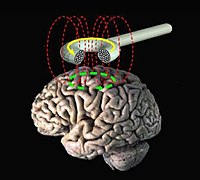
Photo from wikipedia
ABSTRACT Kristiansen, M, Thomsen, MJ, Nørgaard, J, Aaes, J, Knudsen, D, and Voigt, M. The effect of anodal transcranial direct current stimulation on quadriceps maximal voluntary contraction, corticospinal excitability, and… Click to show full abstract
ABSTRACT Kristiansen, M, Thomsen, MJ, Nørgaard, J, Aaes, J, Knudsen, D, and Voigt, M. The effect of anodal transcranial direct current stimulation on quadriceps maximal voluntary contraction, corticospinal excitability, and voluntary activation levels. J Strength Cond Res XX(X): 000-000, 2020-Anodal transcranial direct current stimulation (a-tDCS) has previously been shown to improve maximal isometric voluntary contraction (MVIC), possibly through an upregulation of corticospinal excitability. Because muscle strength is an essential part of the performance of many sports, any ergogenic effect of a-tDCS on this parameter could potentially increase performance outcomes. The purpose of this study was to investigate the effect of a-tDCS on MVIC, voluntary activation levels (VALs), and corticospinal excitability, assessed by eliciting motor-evoked potentials (MEPs), in untrained subjects. Thirteen subjects completed 2 test sessions in which they received either a-tDCS or sham stimulation for 3 consecutive intervals of 10 minutes, separated by 5-minute breaks. Before and after each stimulation session, transcranial magnetic stimulation was used to elicit MEPs, and femoral nerve stimulation was used to assess VAL by measuring twitch torque during an MVIC test and in a relaxed state. Two-way analyses of variance with statistical significance set at p ≤ 0.05 were used to test for differences. A significant main effect was identified, as the MVIC pre-test (271.2 ± 56.6 Nm) was on average 4.1% higher compared to the post-test (260.6 ± 61.4 Nm) (p = 0.05). No significant differences were found in MEP, MVIC, or VAL as a result of stimulation type or time. In healthy subjects, the potential for improvement in corticospinal excitability may be negligible, which may in turn explain the lack of improvements in MEP, MVIC, and VAL after a-tDCS. The small decrease in MVIC for both conditions and nonsignificant changes in MEP and VAL do not justify the use of a-tDCS in combination with sporting performance in which the intent is to increase maximal isometric strength performance in the quadriceps muscle of healthy subjects.
Journal Title: Journal of strength and conditioning research
Year Published: 2021
Link to full text (if available)
Share on Social Media: Sign Up to like & get
recommendations!